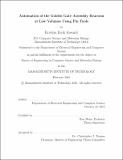| dc.contributor.advisor | Ron Weiss. | en_US |
| dc.contributor.author | Kaseniit, Kristjan Eerik | en_US |
| dc.contributor.other | Massachusetts Institute of Technology. Department of Electrical Engineering and Computer Science. | en_US |
| dc.date.accessioned | 2016-12-22T15:17:48Z | |
| dc.date.available | 2016-12-22T15:17:48Z | |
| dc.date.copyright | 2016 | en_US |
| dc.date.issued | 2016 | en_US |
| dc.identifier.uri | http://hdl.handle.net/1721.1/105993 | |
| dc.description | Thesis: M. Eng. in Computer Science and Molecular Biology, Massachusetts Institute of Technology, Department of Electrical Engineering and Computer Science, 2016. | en_US |
| dc.description | This electronic version was submitted by the student author. The certified thesis is available in the Institute Archives and Special Collections. | en_US |
| dc.description | Cataloged from student-submitted PDF version of thesis. | en_US |
| dc.description | Includes bibliographical references (pages 169-174). | en_US |
| dc.description.abstract | The ability to quickly and reliably create new DNA constructs has been pushing forward many fields, including synthetic biology. This thesis investigated increasing the capability of creating genetic circuits through cost reduction and automation using Golden Gate assembly as a model assembly method. Nearly 20-fold reduction in cost was achieved by lowering the total reaction volume as well as the amount of enzymes used, the major cost factor. Lowering the DNA assembly reaction volume was achieved using pin tools capable of transferring nanoliter scale volumes. Automation was achieved by creating an on-the-fly swappable pin tool adapter for use with the Tecan Freedom EVO liquid handling robot. Software was developed as part of the BioCAD framework to enable easy programmed use of pin tools. Proof-of-concept experiments with pre-mixed DNA inputs reliably achieved 100% correctness at the colony screening level. A seven-way reaction, assembled from individual DNA sources in a total volume of 2 [mu]L using 0.5 units of BsaI and 1 Weiss units of T4 DNA ligase (20 times less than used by researchers manually) showed an efficiency of 10%, with approximately 100 correct colonies formed at the colony screening level, more than necessary for down-stream processing. These proof-of-concept results suggest that using pin tools and automation is a viable approach to reduce the costs of reactions run daily by many synthetic biologists. | en_US |
| dc.description.statementofresponsibility | by Kristjan Eerik Kaseniit. | en_US |
| dc.format.extent | 174 pages | en_US |
| dc.language.iso | eng | en_US |
| dc.publisher | Massachusetts Institute of Technology | en_US |
| dc.rights | M.I.T. theses are protected by copyright. They may be viewed from this source for any purpose, but reproduction or distribution in any format is prohibited without written permission. See provided URL for inquiries about permission. | en_US |
| dc.rights.uri | http://dspace.mit.edu/handle/1721.1/7582 | en_US |
| dc.subject | Electrical Engineering and Computer Science. | en_US |
| dc.title | Automation of the golden gate assembly reaction at low volumes using pin tools | en_US |
| dc.type | Thesis | en_US |
| dc.description.degree | M. Eng. in Computer Science and Molecular Biology | en_US |
| dc.contributor.department | Massachusetts Institute of Technology. Department of Electrical Engineering and Computer Science | |
| dc.identifier.oclc | 965797918 | en_US |
